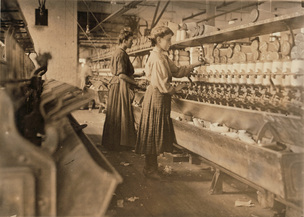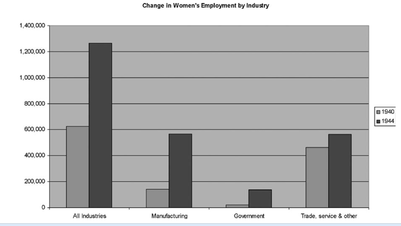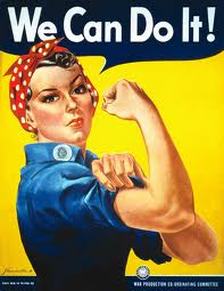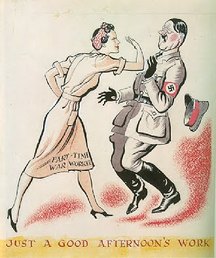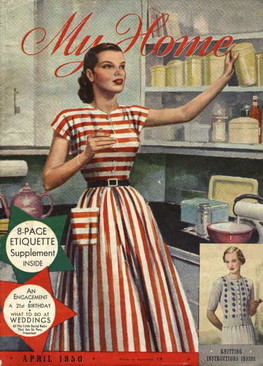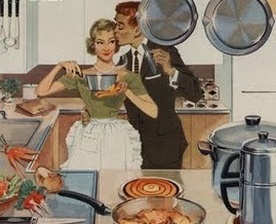Case Study: Women's Movement in the Industrial West
By: Karen Angeles
Before the War
Prior to World War II, most of the women that held jobs outside the home were lower class women that needed to work in order to obtain some extra income to support their families. Many people thought that women of the middle or upper class should never “lower themselves” to get a job. When the Great Depression hit Europe and the United States, some even thought that women who had a job should give them up to unemployed men. While it was common for lower-class women to hold jobs, it was not socially acceptable.
|
During the War
In the United States:
|
World War II officially began on September 1st
of 1939 with Germany’s invasion of Poland. The United States did not engage in
direct military action until December 8th, 1941, after the Japanese attack
on Pearl Harbor and the declaration of war against Japan. As more factories opened
to supply war materials, a labor shortage caused women to eventually be needed
to take over new jobs and the jobs that men had left to fight the war.
As a result of the poor response of women to “report” to work, the government launched a propaganda campaign to encourage women to work. They featured Rosie the Riveter, the ideal woman: hardworking, efficient, and patriotic. Working women, although still largely of the lower class, with older children, and/or unmarried, transitioned from lower-paying factory jobs to higher-paying ones. Those who couldn’t be convinced by patriotic ideals were eventually convinced by economic incentives. Since many were left as the primary providers for their families, more women eventually obtained jobs. Some men had trouble adjusting to the idea that women had to take over jobs that were viewed as traditional male jobs. Male employers did not give women positions of power, which excluded them from any real decision making in a company. However, as more women joined the work force, a lot of men stopped viewing female workers with suspicion and praised their dedication and efficiency.
Since there was a lack of useful commodities during the war, most working women saved a large portion of the money they earned. Eventually, that money was used to buy houses and other luxuries that were unavailable before. |
The purpose of this American propaganda video is to recruiting women to work at the home front in 1944.
|
In Europe
|
The government of many European countries, like Britain, also used propaganda to attract women to join the workforce. Women and children were sometimes evacuated to “safe areas” to guard them from direct attacks, but they were still needed to enlist as nurses, to care for the children, and to produce the needed supply of war materials. Women had long shifts making various things from ammunition uniforms to planes. Even with the “double shift” that women faced (taking care of their children and home, while also working outside the home), they were usually paid less than a man would have been paid for the same job. This was true in the U.S. as well. Women led brief strikes and protests in which their pay was increased, but still were not paid on the level a male of their same skill would have.
Women in both the U.S and Europe were essential to the war effort, especially to the Allies. In comparison to Nazi Germany, women were not allowed to work in German factories because of the unyielding belief that a woman’s place was at home. While foreign women were forced to work in factories, they were viewed as slaves and were not of “pure” race. In some instances, the products manufactured by those slaves was purposely of a bad quality, thus (in a small scale) injuring the German force. |
Women After WWII
|
Even though during World War II women in the United States and most of Europe proved that they could also do a “man’s job,” the end of the war did not result in greater equality for women. When the men came home, they returned to their jobs, and most women returned to working at home. Gender roles were even more strict, featuring the “perfect” woman as a stay-at-home mom taking care of children and running an efficient household.
Excerpt on "How to be a Good Wife" from the Home Economics High School Textbook used in during the 1950's: "HAVE DINNER READY: Plan ahead, even the night before, to have a delicious meal--on time. This is a way to let him know that you have been thinking about him and are concerned with his needs. Most men are hungry when they come home, and having a good meal ready is part of the warm welcome that is needed.
PREPARE YOURSELF: Take fifteen minutes to rest so that you will be refreshed when he arrives. He has just been with a lot of work-weary people. Be a little gay and a little more interesting. His boring day may need a lift. Greet him with a smile. CLEAR AWAY THE CLUTTER: Make one last trip though the main part of the house just before your husband arrives, gathering up children's books and toys, papers, etc. Then run a dust cloth over the tables. Your husband will feel he has reached a haven of rest and order, and it will give you lift too. PREPARE THE CHILDREN: If they are small, wash their hands and faces and comb their hair. They are his little treasures and he would like to see them playing the part. MINIMIZE ALL NOISE: At the time of his arrival, eliminate all noise from the washer, dryer, or vacuum. Encourage the children to be quiet. SOME "DO NOT'S": Don't greet him with problems and complaints. Don't complain if he is late for dinner. Count this as a minor problem compared to what he might have gone through that day. MAKE HIM COMFORTABLE: Have a cool or warm drink ready for him. Have him lean back in a comfortable chair or suggest that he lie down in the bedroom. Arrange his pillow and offer to take off his shoes. Speak in a low, soothing voice. Allow him to relax and unwind. MAKE THE EVENING HIS: Never complain if he doesn't take you to dinner or to other entertainment. Instead, try to understand his world of strain and pressure and his need to unwind and relax. THE GOAL: TO MAKE YOUR HOME A PLACE OF PEACE AND ORDER WHERE YOUR HUSBAND CAN RELAX IN BODY AND SPIRIT." In the excerpt above, it is exemplified the set back women faced after World War II. The passage is very self explanatory, in which the woman's main goal is even specifically spelled out for her.
Even though there were small scale feminist movements taking place around Europe and the United States, although the most successful movements began during the 1960's, in which women were slowly gaining equality. |
|
Works Cited:
"European Women in World War Two." Women in World War Two. History Learning Site UK, n.d. Web. 02 May 2013.
"Women and Work After WWII." PBS. PBS, n.d. Web. 03 May 2013.
"World War II in Europe Timeline." The History Place. The History Place, n.d. Web. 01 May 2013.
"World War II." Women in the Work Force during. The U.S. National Archives and Records Administration, n.d. Web. 01 May 2013.
"Women and Work After WWII." PBS. PBS, n.d. Web. 03 May 2013.
"World War II in Europe Timeline." The History Place. The History Place, n.d. Web. 01 May 2013.
"World War II." Women in the Work Force during. The U.S. National Archives and Records Administration, n.d. Web. 01 May 2013.
